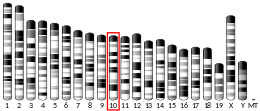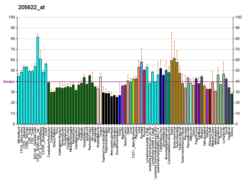SMPD2
Sphingomyelin phosphodiesterase 2 is an enzyme that in humans is encoded by the SMPD2 gene.[5][6]
References
- GRCh38: Ensembl release 89: ENSG00000135587 - Ensembl, May 2017
- GRCm38: Ensembl release 89: ENSMUSG00000019822 - Ensembl, May 2017
- "Human PubMed Reference:". National Center for Biotechnology Information, U.S. National Library of Medicine.
- "Mouse PubMed Reference:". National Center for Biotechnology Information, U.S. National Library of Medicine.
- Tomiuk S, Hofmann K, Nix M, Zumbansen M, Stoffel W (March 1998). "Cloned mammalian neutral sphingomyelinase: functions in sphingolipid signaling?". Proceedings of the National Academy of Sciences of the United States of America. 95 (7): 3638–43. doi:10.1073/pnas.95.7.3638. PMC 19888. PMID 9520418.
- "Entrez Gene: SMPD2 sphingomyelin phosphodiesterase 2, neutral membrane (neutral sphingomyelinase)".
Further reading
- Bonaldo MF, Lennon G, Soares MB (September 1996). "Normalization and subtraction: two approaches to facilitate gene discovery". Genome Research. 6 (9): 791–806. doi:10.1101/gr.6.9.791. PMID 8889548.
- Sawai H, Domae N, Nagan N, Hannun YA (December 1999). "Function of the cloned putative neutral sphingomyelinase as lyso-platelet activating factor-phospholipase C". The Journal of Biological Chemistry. 274 (53): 38131–9. doi:10.1074/jbc.274.53.38131. PMID 10608884.
- Marchesini N, Osta W, Bielawski J, Luberto C, Obeid LM, Hannun YA (June 2004). "Role for mammalian neutral sphingomyelinase 2 in confluence-induced growth arrest of MCF7 cells". The Journal of Biological Chemistry. 279 (24): 25101–11. doi:10.1074/jbc.M313662200. PMID 15051724.
- Jensen JM, Fölster-Holst R, Baranowsky A, Schunck M, Winoto-Morbach S, Neumann C, Schütze S, Proksch E (June 2004). "Impaired sphingomyelinase activity and epidermal differentiation in atopic dermatitis". The Journal of Investigative Dermatology. 122 (6): 1423–31. doi:10.1111/j.0022-202X.2004.22621.x. PMID 15175033.
- Jana A, Pahan K (October 2004). "Human immunodeficiency virus type 1 gp120 induces apoptosis in human primary neurons through redox-regulated activation of neutral sphingomyelinase". The Journal of Neuroscience. 24 (43): 9531–40. doi:10.1523/JNEUROSCI.3085-04.2004. PMC 1955476. PMID 15509740.
- Kimura K, Wakamatsu A, Suzuki Y, Ota T, Nishikawa T, Yamashita R, Yamamoto J, Sekine M, Tsuritani K, Wakaguri H, Ishii S, Sugiyama T, Saito K, Isono Y, Irie R, Kushida N, Yoneyama T, Otsuka R, Kanda K, Yokoi T, Kondo H, Wagatsuma M, Murakawa K, Ishida S, Ishibashi T, Takahashi-Fujii A, Tanase T, Nagai K, Kikuchi H, Nakai K, Isogai T, Sugano S (January 2006). "Diversification of transcriptional modulation: large-scale identification and characterization of putative alternative promoters of human genes". Genome Research. 16 (1): 55–65. doi:10.1101/gr.4039406. PMC 1356129. PMID 16344560.
- Kim HT, Lee JY, Han BG, Kimm K, Oh B, Shin HD, Namkung JH, Kim E, Park T, Yang JM (May 2007). "Association analysis of sphingomyelinase 2 polymorphisms for the extrinsic type of atopic dermatitis in Koreans". Journal of Dermatological Science. 46 (2): 143–6. doi:10.1016/j.jdermsci.2006.12.001. PMID 17212982.
- Tani M, Hannun YA (March 2007). "Neutral sphingomyelinase 2 is palmitoylated on multiple cysteine residues. Role of palmitoylation in subcellular localization". The Journal of Biological Chemistry. 282 (13): 10047–56. doi:10.1074/jbc.M611249200. PMID 17272284.
This article is issued from Wikipedia. The text is licensed under Creative Commons - Attribution - Sharealike. Additional terms may apply for the media files.




